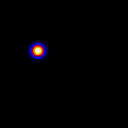

A Forward-Fit solution: URL="hsi_20000901_flare01.ps"
Comments:
- Choose time 00:03:00-00:03:04 UT to bracket flare peak
- Choose energy range 12-100 keV for better photon statistics
- Choose detectors #2-8 to obtain high resolution
- The gaussian width of the source is found to be w=1.9",
that's about the best that can be done with grid>#2 for a point source
- Retrieved count rate is N=10,754/s which is 7% close to the simulation
- C-statistic is C=1.09+/-0.09, indicating that the model is adequate.
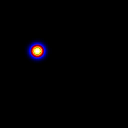
A Forward-Fit solution: URL="hsi_20000901_flare02.ps"
Comments:
- Choose full 8 s of flare peak (00:03:00-00:03:08 UT)
- The gaussian width of the source is found to be w=2.0",
- Retrieved count rate is N=56,067/s which is 6% close to the simulation
- C-statistic is C=1.42+/-0.36 (mainly caused by high values in det#2, 5 and 8)
 dt=4 s
dt=4 s
 dt=200 s
dt=200 s
A Forward-Fit solution:
URL="hsi_20000901_flare03.ps"
URL="hsi_20000901_flare03b.ps"
Comments:
- In the first version we choose a time interval of dt=4 s. The algorithm finds
no significant modulation in detectors #2,3 for this weak source and ignores
the fine grids. As a result, the gaussian width of this point source is
retrieved to 5.8". This illustrates that only upper limits of the source
size can be retrieved for weak sources.
- In the second attempt we choose the full time interval of dt=200 s, on the
expense of longer computation time, but the
source size was not improved. Obviously the C-statistic does not benefit from
the improved photon statistics for a large number of bins with little counts
per bin. This is a case where a count-sorted statistics could give a better
fit than a timebin-sorted statistics, perhaps?
(The ratio of the model counts is about 1/50, see right margin of
time profile plot hsi_20000901_flare03b.ps, indicating a scaling error in the modelmap).
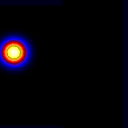
A Forward-Fit solution: URL="hsi_20000901_flare04.ps"
Comments:
- This simulation has a gaussian time profile with FWHM=8 s. To have a near-steady
time profile we choose the middle 4 s near the flare peak and obtained a
C-statistic of C=1.14+/-0.15, which indicates that the model is adequate.
- We included detector #2-9 and retrieved a gaussian width of w=1.9" for this
point source.
- The retrieved count rate is N=10,259/s, within 2% of the simulated counts.
- To save time we used only a grid of 32x32, that's why the source is close to
the edge.
A Forward-Fit solution:
Comments:
- This flare with time variability of <100 ms over 0.5 s is so CHALLENGING
that we need first to include the time variability in the model time profiles.
No satisfactory image exists yet!
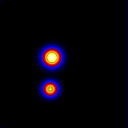
A Forward-Fit solution: URL="hsi_20000901_flare06.ps"
Comments:
- We choose a time interval of dt=4 s at the peak of the flare, because the
overall time profile is a gaussian with FWHM=10 s
- Specifying two sources in the forward-fitting retrieves two components
with gaussian widths of 5.8" and 4.6" and flux ratio of 1:0.75, with a
separation of 32.4" (close to simulated separation of 30").
- C-statistic C=1.39+/-0.45 is definitely better for a two-component model
than for a one-component model (C=1.5+/-0.4).

A Forward-Fit solution: URL="hsi_20000901_flare07.ps"
Comments:
- We select the following forward-fitting parameters: number of sources=2,
number of parameters=6 (ellipticals), number of iterations=30, nx=ny=32, pixelsize=1".
For forward-fitting of a model with two ellipses requires the optimization of 2x6=12 free
parameters, which demands more iteration cycles than a single source with 4 free parameters.
The two reconstructed ellipses are found to have gaussian widths of wx=3.5" and 2.8",
and eccentricities of e=1.11 and 1.04, which yields widths of wy=wx*(1+e)=7.4" and 5.7".
So the minor (2*wx) and major diameters (2*wy) are about 7"x15" and 5.6"x11.4",
somewhat less longish than the simulated 4"x20" ellipses. The C-statistic is C=1.59+/-0.49.
Increasing the resolution and number of iterations could perhaps improve the results slightly.

A Forward-Fit solution: URL="hsi_20000901_flare08.ps"
Comments: - Seems to be same case as flare #7
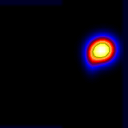
A Forward-Fit solution: URL="hsi_20000901_flare09.ps"
Comments:
- Despite the fact we selected only the finest grids (#1-4), the highest
resolution (pixelsize=1"), we were not able to resolve the closely-spaced (3")
double source. Perhaps we should attempt pixelsizes of 0.5" (but GUI does not
allow you to choose <1" at this time).
A Forward-Fit solution:
Comments:
- This simulation contains extended source, but it looks like that it
doesn't modulate at all. No solution could be obtained with forward-fitting
in a first attempt.